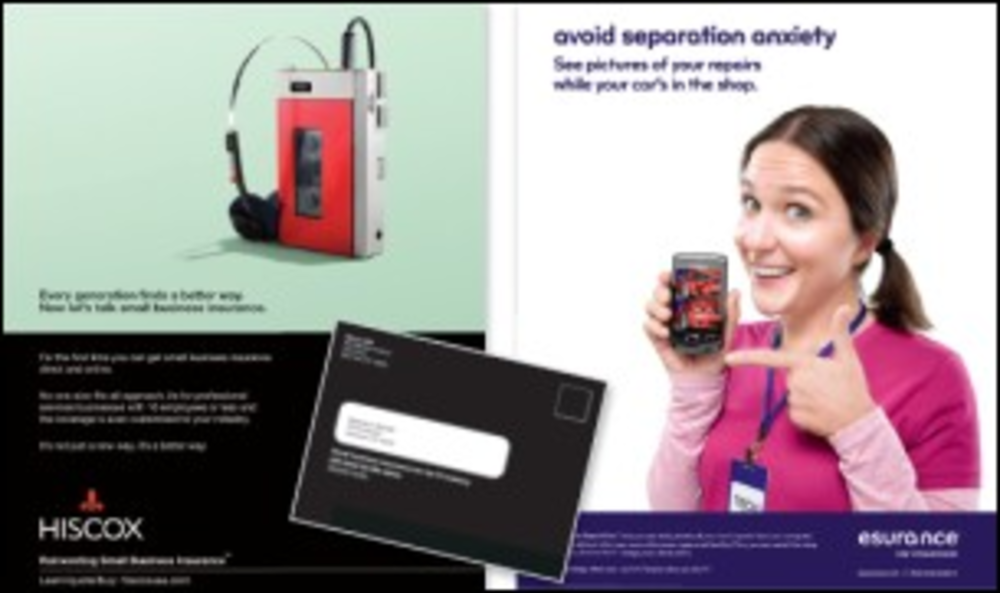Insurance marketers kicked off 2011 with a plethora of new direct response campaigns, from TV spots to Facebook sweepstakes. Insurance isn’t typically a seasonal product, but December into January has long been an important two-month period for insurance sales, including health, auto and other insurance sectors as customers review and renew or ditch policies in the new year.
Hiscox, a New York-based small business insurer, got into the online instant quote game in late November, and is focusing on acquisition in 2011, according to Philip Thorn, head of US direct marketing at the company.
“Insurance is a necessary evil,” so great customer service and accountability is one of the most important drivers of customer acquisition, says Thorn. “We’re putting all customer reviews on our website each week to build trust and transparency,” he says.
While many direct marketers reinvested in media channels that have worked for them in the past — national television for auto insurers and direct mail for health insurers — they’ve also looked to social media and mobile for lead generation and sales, as well as a means to build brand preference.
Darren Howard, VP of marketing at Esurance, an online auto insurance provider, says that while direct response constitutes the backbone of most marketing programs the company executes, building brand preference with consumers pays off down the road. Esurance spent close to $100 million on media in 2010, the bulk of which funded national DRTV programs, but Howard recognizes that many of customers are spending more time on their computers.
Health insurer exceeds goal
Part of the Obama administration’s health reform legislation shortened the annual marketing and enrollment period for Medicare Advantage, from six months to three months. Click to read the case study.
As part of a “comprehensive” online campaign, which includes search, Facebook sweepstakes, 15-second pre-roll videos across Yahoo’s ad network and on CNN.com, Esurance is also testing demand-side platform (DSP) marketing “for the first time,” says Howard. “DSP really learns in real-time which display advertising is producing the best conversion rate, and then reaches out and targets those sites and the types of sites that those people are visiting.”
Esurance partnered with DataXu, a Boston-headquartered DSP and media management provider, for the program.
Direct mail hasn’t been part of Esurance’s marketing mix for several years due to low performance reasons, but it might try some testing “with a few partners” later this year, says Howard.
Direct mail may not be a winning proposition for auto insurance marketers, but it’s the bread and butter of the health insurance sector, according to Cindy Willett, senior manager, acquisition programs at Blue Cross Blue Shield Florida (BCBSF). New direct mail creative and increasingly sophisticated predictive modeling led to “huge successes” with direct mail in 2010, according to Willet. In 2011, direct mail “continues to be the workhorse of our direct tactics,” she says. Today, though, Blue Cross’ mail “pushes pretty hard to the Web,” with coded URLs that allow for tracking, and it also directs potential customers to an onsite call center at Blue Cross.
US-based call centers give marketers a leg up, according to Adrea Rubin, a veteran direct marketer with a client list including Mutual of Omaha, Colonial Penn and Physicians Mutual. “People do respond on the phone [to insurance-related direct mail], but you’re only as good as the agent on the phone,” she says. Willett says most of Blue Cross’ responses do come in by telephone, followed by business reply card and lastly, Internet.
As for direct mail copy, some health insurers are using longer-form information to help customers understand current healthcare law, and copywriters are also thinking about the coming onslaught of aging baby boomers, says Rubin.
Howard calls national television the most efficient media buy for Esurance. “We buy our national TV as DRTV, so we typically get the best rates and the best clearance across cable networks,” he says. “We’re also a big player in direct response syndication, but we do not really play on a regular basis in the broadcast prime world. Esurance’s competitors like TV, too. Progressive, Geico and Allstate all launched new spots at the end of 2010 or the beginning of this year, and Geico partnered with Xtranormal (a DIY animation site that entered the national consciousness with a viral video making fun of iPhone obsessives) for a TV spot.
Radio, on the other hand, has been a less successful affair lately, admits Howard, as more listeners move away from traditional, terrestrial radio. “We’re still running terrestrial radio at this point, but it’s taking us a lot more radio station buys in a market to really achieve the reach that we want to achieve in that market,” says Howard.
Esurance has also launched iPhone and Windows 7 mobile apps in the last year.
Howard says the iPhone app, primarily for use by existing customers, launched last summer, and has had 30,000 downloads to date. Esurance has also experimented with Google’s AdMob for mobile users. Blue Cross recently launched a mobile website and communicates with members when they log on, says Lynn Locke, senior manager of database marketing at BCBS Florida.
Online, Esurance’s Facebook sweepstakes, “The Best Nickname Contest Ever,” asks participants to submit a photo of their car, and explain how the car got its nickname. Ten winners are chosen each week, and one winner picks up $522 — the amount of money a consumer would supposedly save with an Esurance policy — each week. The contest will run January 5 to March 11.
Howard believes the contest can build brand preference “so that next time they’re in the market for auto insurance, they’ll come and get a quote from us.”







